
Philibert Commerson, sometimes spelled Commerçon by contemporaries, was a French naturalist, best known for accompanying Louis Antoine de Bougainville on his voyage of circumnavigation in 1766–1769.

Ostorhinchus fleurieu is a species of cardinalfish native to the Red Sea and Persian Gulf, the Gulf of Oman, and the waters around East Africa, Seychelles, India, Sri Lanka, the Indo-Malayan region, and Hong Kong., south to the Ashmore Reef, Western Australia. It is the type species of the genus Ostorhinchus. The specific name honours the French explorer and hydrographer Charles Pierre Claret, comte de Fleurieu (1738-1810) who was a colleague and friend of Lacepède's.

Reganochromis calliurus is a species of cichlid endemic to Lake Tanganyika in East Africa. It lives over a sandy substrate in deeper coastal waters, to depths of at least 60 m (200 ft). Its preferred diet consists mostly of shrimp. It can reach a total length of 15 cm (5.9 in). This fish can also be found in the aquarium trade. It is currently the only known member of its genus.

The sulfurhead aulonocara or sulfurhead peacock is a species of haplochromine cichlid which is endemic to Lake Malawi in the country of Malawi and has only been observed on West Reef and Eccles Reef. It is threatened by collection for the aquarium trade and this has caused a 70% reduction in numbers. In this mouthbrooding species, the eggs are cared for by the females only, and it is found over mixed sand and rocky areas where they hunt small invertebrates in the sand. It closely resembles the blue orchid aulonocara though it develops a yellow blaze across its dorsal In the past these two taxa have been considered to be subspecies. The specific name honours Hans-Joachim Mayland, an author on cichlids and a fishkeeper, brought the species to the attention of Ethelwynn Trewavas.
Baileychromis centropomoides is a species of cichlid endemic to Lake Tanganyika in east Africa. This fish grows to a length of 16.8 centimetres (6.6 in) TL. It is currently the only known member of its genus. The generic name is a compound noun, made up of the surname Bailey, in honour of the American ichthyologist Reeve Maclaren Bailey (1911-2011) of the University of Michigan, and the Greek word chromis which was used by Aristotle for a type of fish. This was probably the drum Sciaenidae and may be derived from the word chroemo which means "to neigh" in reference to the noise made by drums. This word was applied to a number of percomorph fishes, such as damselfish, cardinalfish, dottybacks, wrasses and cichilds, by ichthyologists as these were thought to be closely related.

Ostorhinchus hoevenii is a species of ray-finned fish from the family Apogonidae, the cardinalfishes, it is from the Indo-West Pacific north to Japan and south to Australia. It occasionally makes its way into the aquarium trade. It grows to a size of 6 cm in length. It occurs in small groups among corals, sea urchins, crinoids and algae. The specific name honours the Dutch zoologist Jan van der Hoeven (1801-1868).
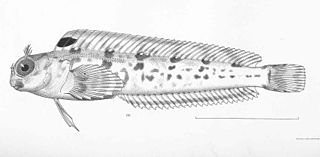
Parahypsos piersoni is a species of combtooth blenny found in coral reefs in the eastern Pacific ocean, from Costa Rica to Peru. The specific name honours C.J. Pierson, who was a member of the expedition to Panama on which the type was collected.
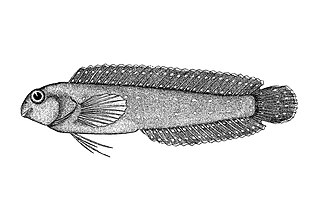
Parenchelyurus hepburni, Hepburn's blenny or the bluespotted blenny, is a species of combtooth blenny found in coral reefs in the Pacific and Indian Ocean.

Acanthemblemaria hancocki, Hancock's blenny, is a species of chaenopsid blenny found in coral reefs around Costa Rica and Panama, in the eastern central Pacific ocean. and can reach a maximum length of 4.5 cm (1.8 in) TL. This species feeds primarily on zooplankton. The specific name honours the leader of the expedition on which the type was collected, the oil magnate and philanthropist Captain George Allan Hancock (1875-1965).
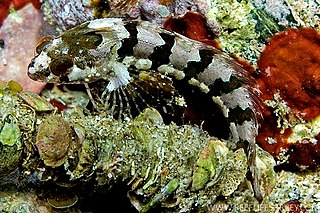
Heteroclinus whiteleggii, Whitelegg's weedfish, is a species of clinid native to reefs around New South Wales, Australia. This species can reach a maximum length of 10 centimetres (3.9 in) TL. The specific name honours the naturalist Thomas Whitelegge (1850-1927) who was a friend of Ogilby's friend and who collected the type.

Ostorhinchus neotes, the mini cardinalfish, is a species of ray-finned fish, a cardinalfish, from the family Apogonidae. It is found in the western central Pacific Ocean from the Philippines south to Australia and has been reported from Tonga. It is a small cardinalfish with a small semi-transparent body which has a black stripe along its flanks underneath the skin, and a large, black spot at the base of the caudal fin. It occurs in lagoons and outer reefs where the water is relatively clear and normally where there are soft corals or gorgonian fans. It forms small schools, but mates in couples and the male mouth broods the eggs. It shelters in crevices in the reef.

Fowleria is a genus of fishes in the family Apogonidae native to the Indian and Pacific Oceans. The name of this genus honors the American ichthyologist Henry Weed Fowler ( ) of the Academy of Natural Sciences of Philadelphia, who attended Stanford University, where he was a student of David Starr Jordan's.

Gymnapogon is a genus of fish in the family Apogonidae. They are native to the Indo-West Pacific and central Pacific Oceans, where they occur in reefs and nearby habitat types. These species are usually no more than 5 centimeters long and have semitransparent bodies without scales. The genus name is a compound noun formed by combining the Greek gymnos meaning "naked", referring to the lack of scales in the type species, Gymnapogon japonicus, and Apogon, the type genus of the Apogonidae. One species, the B-spot cardinalfish, is notable for its larvae being rather large, conspicuous and fast-swimming.
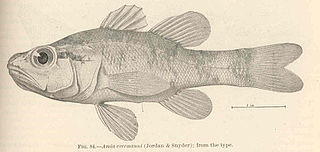
Zapogon evermanni, Evermann's cardinalfish, is a species of cardinalfish native to tropical reefs in the Indian and Pacific Oceans and the western Atlantic Ocean.

Caesio teres, the yellow and blueback fusilier, beautiful fusilier, blue and gold fusilier or yellow-tail fusilier, is a species of marine, pelagic ray-finned fish belonging to the family Caesionidae. It occurs in the Indian and Western Pacific Oceans.
Cable's goby is a species of goby endemic to reefs around the Galápagos Islands. This species grows to a length of 7 centimetres (2.8 in) SL. This species is the only known member of its genus. The specific name honours the United States Government biologist Louella E. Cable (1900-1986), who illustrated this goby for the describer Isaac Ginsburg, and drew his attention to its separated ventral fins.
The flagtail wormfish is a species of wormfish native to the Pacific coast of the Americas from Mexico to Colombia as well as the Galápagos Islands. It is an inhabitant of tide pools and reefs being found down to a depth of about 8 metres (26 ft). This species grows to a length of 6.2 centimetres (2.4 in) SL. This species is the only known member of its genus. The generic name is a compound noun made up of the surname Clark, to honour the American ichthyologist H. Walton Clark (1870-1941) who described the species and ichthys the Greek for "fish".
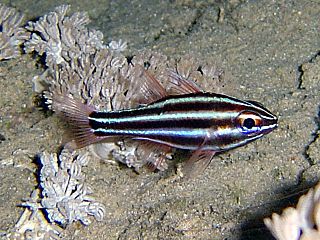
Ostorhinchus cookii, common names Cook's cardinalfish, Cook's soldierfish, blackbanded cardinal, blackbanded cardinalfish, is a species of marine fish in the family Apogonidae.

Ostorhinchus capricornis, also known as the Capricorn cardinalfish, is a species of ray-finned fish, a cardinalfish from the family Apogonidae which occurs around reefs in the western Pacific Ocean.
Epigonus affinis, the smooth-nose deepwater cardinalfish, is a species of deepwater cardinalfish found in the eastern-central Atlantic Ocean. This fish occurs at depths of 300 m (980 ft).

















